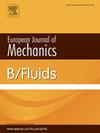Turbulent entrainment in buoyant releases from horizontal gravity current to vertical planar wall plume
IF 2.5
3区 工程技术
Q2 MECHANICS
引用次数: 0
Abstract
This paper examines the dynamics of a supercritical, steady, miscible, two-dimensional gravity current flowing along an inclined boundary, with a particular focus on the entrainment, which refers to the mixing between the gravity current and the surrounding fluid. Specifically, the study investigates the combined effects of the Richardson number and slope on the entrainment coefficient . To address these objectives, a theoretical study and large-eddy simulations (LES) were conducted, varying the slope angle from 0° to 90°, while maintaining constant injection conditions.
The theoretical investigation of gravity currents resulted in the extension of the theoretical model of Ellison and Turner (1959) in the general non-Boussinesq case as well as the identification of two specific angles: the critical angle , beyond which no transition between supercritical to subcritical behaviour is observed, and the supercritical angle , above which the flow acquires inertia immediately after injection.
On the other hand, the simulations revealed three distinct flow regimes for our source conditions. The first regime, observed at low slopes, exhibits a non-monotonic behaviour, characterized by a transition from a supercritical to a subcritical regime. The second regime, related to the critical angle , occurs at intermediate slopes, where the flow remains inertial throughout. In the third regime, related to steeper slopes, the supercritical angle has been exceeded and the flow immediately gains inertia upon injection. The simulations also enabled an analysis of , which was found to increase with slope and reach a constant value at .
Moreover, a new entrainment law was developed, incorporating both the effects of the Richardson number and the slope: . This law provides a description of the entrainment behaviour across the full range of slope angles. Comparisons between the LES results and the theoretical model demonstrate that the proposed entrainment law offers improved accuracy over existing models for all slope configurations, including the extreme cases of gravity currents and planar wall plumes .
水平重力流对垂直壁面羽流的浮力释放湍流夹带
本文研究了沿倾斜边界流动的超临界、稳定、混相二维重力流的动力学,特别关注了夹带,这是指重力流与周围流体之间的混合。具体而言,该研究探讨了理查德森数Ri和斜率θ对夹带系数e的综合影响。为了实现这些目标,进行了理论研究和大涡模拟(LES),在保持恒定注入条件的情况下,将斜率角从0°变化到90°。重力流的理论研究导致了Ellison和Turner(1959)在一般非boussinesq情况下的理论模型的扩展,并确定了两个特定的角度:临界角θc,超过这个角就不会观察到超临界到亚临界行为之间的转变,以及超临界角θsc,在这个角以上,流动在注入后立即获得惯性。另一方面,模拟揭示了我们的源条件下三种不同的流动形式。在低斜率处观察到的第一种状态表现出非单调的行为,其特征是从超临界到亚临界状态的过渡。第二种状态,与临界角θc有关,发生在中间斜坡处,在那里流动始终保持惯性。在第三种情况下,与更陡的斜坡有关,超临界角θsc已经超过,注入后流动立即获得惯性。模拟还可以对E进行分析,发现E随坡度增加而增加,并在θ=90°时达到恒定值。此外,一个新的夹带定律被发展,结合了理查德森数和斜率的影响:E=0.002cos(θ)/Ri+0.09sin1/2(θ)。这个定律描述了在整个坡角范围内的夹带行为。LES结果与理论模型之间的比较表明,所提出的夹带规律比现有模型在所有坡度配置下的精度都有提高,包括重力流(θ=0°)和平面羽流(θ=90°)的极端情况。
本文章由计算机程序翻译,如有差异,请以英文原文为准。
求助全文
约1分钟内获得全文
求助全文
来源期刊
CiteScore
5.90
自引率
3.80%
发文量
127
审稿时长
58 days
期刊介绍:
The European Journal of Mechanics - B/Fluids publishes papers in all fields of fluid mechanics. Although investigations in well-established areas are within the scope of the journal, recent developments and innovative ideas are particularly welcome. Theoretical, computational and experimental papers are equally welcome. Mathematical methods, be they deterministic or stochastic, analytical or numerical, will be accepted provided they serve to clarify some identifiable problems in fluid mechanics, and provided the significance of results is explained. Similarly, experimental papers must add physical insight in to the understanding of fluid mechanics.

 求助内容:
求助内容: 应助结果提醒方式:
应助结果提醒方式:


